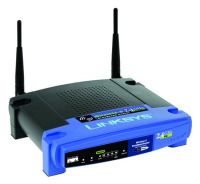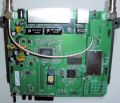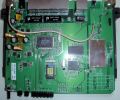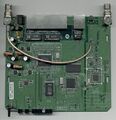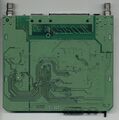Linksys WRT54G v3.0
Linksys WRT54G v3.0
Availability: common
Manuf (OEM/ODM): CyberTAN
FCC approval date: 17 September 2004
Country of manuf.: China
S/N prefix: CDF8
Series: WRT54G
Type: wireless router
FCC ID: Q87-WT54GV22
IC ID: 3839A-WT54GV22
Power: 12 VDC, 1 A
Connector type: barrel
Conn. measurements: 5.2 mm (OD), 2.5 mm (ID), 11 mm (LEN)
CPU1: Broadcom BCM4712 (216 MHz)
FLA1: 4 MiB4,194,304 B <br />32,768 Kib <br />4,096 KiB <br />32 Mib <br />0.00391 GiB <br /> (Intel TE28F320C3BD70)
RAM1: 16 MiB16,777,216 B <br />131,072 Kib <br />16,384 KiB <br />128 Mib <br />0.0156 GiB <br /> (Hynix HY5DU281622ET-J)
Expansion IFs: none specified
WI1 chip1: Broadcom BCM4712
WI1 chip2: Broadcom BCM2050
WI1 802dot11 protocols: bg
WI1 antenna connector: RP-TNC
ETH chip1: Broadcom BCM4712
Switch: Broadcom BCM5325E
LAN speed: 100M
LAN ports: 4
WAN speed: 100M
WAN ports: 1
bg
Stock FW OS: Linux
TPFirmware supported: DD-WRT • (List), OpenWrt • (List | Dev | DLs), Tomato • (List | DLs), TomatoUSB • (List | DLs), Broadband-Hamnet
Default SSID: linksys (50 addl. devices)
Default IP address: 192.168.1.1
the IP 192.168.1.1 is used by 1305 additional devices
of which 154 are Linksys devices
Default login user: blank
Default login password: admin
blank:admin credentials used by 302 additional devices
of which 143 are Linksys devices
| FCC ID | |
|---|---|
| Linksys WRT54G v2.2 | Q87-WT54GV22 |
| Linksys WRT54G v3.1 | Q87-WT54GV22 |
| Linksys WRT54GS v1.1 | Q87-WT54GV22 |
| Linksys WRT54GS v2.0 | Q87-WT54GV22 |
| Linksys WRT54GS v2.1 | Q87-WT54GV22 |
| CPU1 brand | WI1 chip1 brand | WI1 chip2 brand | |
|---|---|---|---|
| Linksys WRT54G v1.0 | Broadcom | Broadcom | Broadcom |
| Linksys WRT54G v1.1 | Broadcom | Broadcom | Broadcom |
| Linksys WRT54G v2.0 | Broadcom | Broadcom | Broadcom |
| Linksys WRT54G v2.2 | Broadcom | Broadcom | Broadcom |
| Linksys WRT54G v3.0 | Broadcom | Broadcom | Broadcom |
| Linksys WRT54G v3.1 | Broadcom | Broadcom | Broadcom |
| Linksys WRT54G v4.0 | Broadcom | Broadcom | Broadcom |
| Linksys WRT54G v5.0 | Broadcom | Broadcom | Broadcom |
| Linksys WRT54G v6.0 | Broadcom | Broadcom | Broadcom |
| Linksys WRT54G v7.0 | Atheros | Atheros | |
| Linksys WRT54G v7.2 | Broadcom | Broadcom | |
| Linksys WRT54G v8.0 | Broadcom | Broadcom | |
| Linksys WRT54G v8.1 | Broadcom | Broadcom | |
| Linksys WRT54G v8.2 | Broadcom | Broadcom | |
| Linksys WRT54GH | Ralink | Ralink |
For a list of all currently documented Broadcom chipsets with specifications, see Broadcom.
Wireless-G Broadband Router
v3.0 is the first unit that included the switch that would be used in the future for SecureEasySetup.
- OD/ID/Len measurements may not be exact
Links of Interest
- WRT54G series on Wikipedia
- Linksys WRT54Gxx page on the DD-WRT wiki
- WRT54G page on the OpenWrt wiki
- WikiDevi.Wi-Cat.RU:DD-WRT/NEWD or VINT
Flashing
| NOTE: During configuration or flashing a device, the only things that should be hooked to the device is the computer and power. |
Flashing DD-WRT
| For DD-WRT, These units seems to run more stable on the VINT builds. |
| WARNING: Requires K2.4 for DD-WRT, Do not flash anything else! |
- Linksys WRT54G v3.0
- VINTage firmware. Details here.
- Read the peacock announcement found here: http://www.dd-wrt.com/phpBB2/viewtopic.php?t=51486
- Do a Hard reset or 30/30/30 on the router according to note 1 of the peacock announcement (30/30/30)
- Set a static IP on your computer to 192.168.1.7. Subnet mask should be 255.255.255.0.
- Connect the lan cable from your computer to a LAN port of your router. Make sure your router is plugged in. Nothing should be connected to your computer or the router except the lan cable between them. Turn your firewall and any wireless computer connections OFF.
- Power cycle the router (uplug the power from the router for 30 seconds and then plug it back in)
- Open your browser to 192.168.1.1 by putting that in the browser address window of your browser. You should open the linksys webgui and NOT a page that says Management Mode. If you see management mode, power cycle the router again.
- Leave the username blank and enter "admin" as the password
- Go to administration and firmware upgrade
- Navigate to the folder that you are using, and select dd-wrt.v24-15230_VINT_mini.bin
- Hit upgrade
- When you get a message that the upgrade is successful, wait FIVE FULL minutes before continuing.
- If you don't get success, repeat from steps 6 up to this one. If you still don't get success, clear your browser cache. Try using a different browser as well, to navigate to 192.168.1.1.
- When you can access the dd-wrt webgui using a browser at 192.168.1.1, power cycle the router.
- When you can again access the dd-wrt webgui using a browser at 192.168.1.1, do another Hard reset or 30/30/30 on the router.
- At this point you can choose to put a different build on, depending on what you needs are.
- Reset your computer ethernet connection to auto IP and auto DNS
- Check for recommended builds here.
Flashing OpenWrt
Reverting
Reverting to OEM Firmware from DD-WRT
- Read the peacock announcement found here: http://www.dd-wrt.com/phpBB2/viewtopic.php?t=51486
- Do a Hard reset or 30/30/30 on the router according to note 1 of the peacock announcement (30/30/30)
- Set a static IP on your computer to 192.168.1.7. Subnet mask should be 255.255.255.0.
- Connect the lan cable from your computer to a LAN port of your router. Make sure your router is plugged in. Nothing should be connected to your computer or the router except the lan cable between them. Turn your firewall and any wireless computer connections OFF.
- Power cycle the router (uplug the power from the router for 30 seconds and then plug it back in)
- Open your browser to 192.168.1.1 by putting that in the browser address window of your browser. You should open the linksys webgui and NOT a page that says Management Mode. If you see management mode, power cycle the router again.
- Enter your username and password
- Go to administration and firmware upgrade
- Navigate to the folder that you are using, and select WRT54G_v4.21.1_fw.zip once you've unzipped it.
- Hit upgrade
- When you get a success, wait FIVE FULL minutes.
- When you can again access the Linksys webgui using a browser at 192.168.1.1, do another Hard reset or 30/30/30 on the router.
- Reset your computer ethernet connection to auto IP and auto DNS
JTAG-Serial Info
JTAG
JTAG Pinouts
nTRST 1o o2 GND TDI 3o o4 GND TDO 5o o6 GND TMS 7o o8 GND TCK 9o o10 GND nSRST 11o o12 N/C
JTAG Recovery
JTAG Recovery Instructions
Serial
Serial Pinouts
VCC 1 o o 2 VCC TX1 3 o o 4 TX0 RX1 5 o o 6 RX0 N/C 7 o o 8 N/C GND 9 o o 10 GND
Hyper terminal Setup in Windows XP
In Windows XP, Click Start Button - All Programs - Accessories -
Communication - HyperTerminal
Enter a name for the connection, Click ok
Choose com port you adapter is plugged into, Click ok
Set:
Bits per second = 115200
Data Bits = 8
Parity = none
Stop bits = 1
Flow control = none
Click ok
Click File - Save As, and select a place to save it to so you
don't have to enter the settings again.
Putty Setup in Windows XP
After installing putty, run it Serial line = The COM port your using for serial (ie. COM3) Speed = 115200 Click on Serial under Connection Serial line to connect to = same as above (Serial line) Speed (baud) = 115200 Data bits = 8 Stop bits = 1 Parity = none Flow control = none Click Session Enter a name for your connection under saved sessions Click Save Click Open
vlan Info
DD-WRT vlan Info
1 2 3 4 | Case labels 1 2 3 4 | NVRAM ports
Pictures
